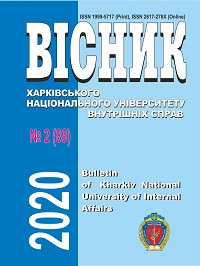Legal Protection of Innovations in the Regime of Commercial Secrets, Industrial Property: Comparative Analysis
DOI:
https://doi.org/10.32631/v.2020.2.18Keywords:
legal regime, trade secret, innovation, industrial property law, patent, personal non-property rights, exclusive property rights.Abstract
The author of the article presents a comparative legal analysis of trade secret and industrial property regimes. Based on the analysis, the following distinctive features of legal regimes of trade secrets and industrial property are identified. The legal regime of industrial property provides strict criteria for the qualification of certain innovations as inventions, utility models, industrial designs. On the contrary, any commercially valuable innovations can be protected in the mode of trade secret. The legal regime of industrial property is a legal monopoly, as it provides the receipt of a security document (patent, declaratory patent). The trade secret regime is provided by a de facto monopoly, as it is ensured by the application of certain protective measures. The regime of industrial property rights presupposes the existence of both personal non-property and property exclusive rights. The trade secret regime provides only exclusive property rights. It has been identified that a common issue for both industrial property rights and trade secrets is the controversial application of "binding clauses" in licensing agreements, as they are contrary to the rules of fair competition. It is noted that the use of trade secrets to protect innovations is appropriate at the stage of development, mass production. When commercializing innovations, it is advisable to apply the regime of industrial property rights.
Downloads
References
2. Boshytskyi Yu.L., 2018. Innovative prospects of Ukraine in the context of optimization of legal protection of intellectual property [Innovatsiini perspektyvy Ukrainy v konteksti optymizatsii pravovoi okhorony intelektualnoi vlasnosti]. Časopis Kiïvsʹkogo unìversitetu prava – Law Review of Kyiv University of Law, No. 4, рр. 201-209.
3. Demianchuk H.V., 2014. Industrial property in the process of commercialization of innovations [Obiekty promyslovoi vlasnosti v protsesi komertsializatsii innovatsii]. Nauka ta ìnnovacìï – Science and Innovation, Vol. 9, No. 5, рр. 51-57.
4. Kravchenko O., 2017. Improving the legislation of Ukraine on trade secrets of business entities [Vdoskonalennia zakonodavstva Ukrainy shchodo komertsiinoi taiemnytsi subiektiv hospodariuvannia]. Ìnformacìâ ì pravo – Information and Law, No 2, рр. 13-19.
5. Beckerman-Rodau A., 2002. The Choice between Patent Protection and Trade Secret Protection: A Legal and Business Decision. Journal of the Patent & Trademark Office Society, [online]. Vol. 84. https://papers.ssrn.com/sol3/papers.cfm?abstract_id=704644 [Accessed 13 June 2020].
6. Finnegan M., 1976. International patent and know-how licensing. Ind. Property, No. 9, рр. 225-226.
7. Shtumpf G., 1976. Know-how transfer agreement [Dogovor o peredache nou-khau]. Moscow: Progress. (Transl. Dergachev V.I.).
8. Volynets-Russet E.Ya., 1999. Commercial implementation of the invention and know-how [Kommercheskaya realizatsiya izobreteniya i nou-khau]. Moscow: Yurist.
9. Pychinskii V.K. and Kulagin M.I. (eds), 1987. Civil, commercial and family law of the capitalist countries: a collection of regulations: legislation on companies, monopolies and competition [Grazhdanskoe, torgovoe i semeinoe pravo kapitalisticheskikh stran: sbornik normativnykh aktov: zakonodatel`stvo o kompaniyakh, monopoliyakh i konkurentsii]. Moscow: Izdatel`stvo UDN.
10. Jornal Officiel des Communautes Europeennes, 1975, 22 aout; GRUR, Int. S. 44.



